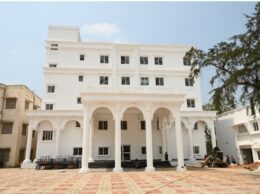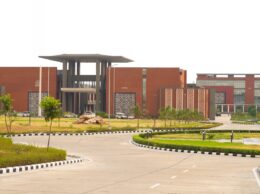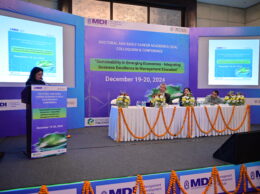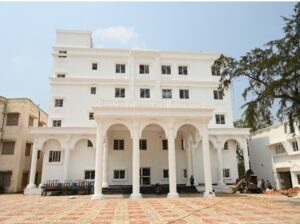Chennai, 5th November 2019: Indian Institute of Technology Madras in collaboration with Phoenix Medical Systems has launched India’s first indigenously-designed ‘Standing Wheelchair.’ It enables a differently-abled person requiring a wheelchair to shift from sitting to standing position, and vice versa, independently and in a controlled manner.
The Standing Wheelchair was launched at IIT Madras Research Park today (5th November 2019) in the presence of Shri Thaawarchand Gehlot, Honourable Minister for Social Justice and Empowerment, Government of India, researchers, students, staff and faculty of IIT Madras besides other stakeholders in the project.
Called ‘Arise,’ the Standing Wheelchair was designed and developed by the TTK Center for Rehabilitation Research and Device Development (R2D2) at IIT Madras, headed by Prof. Sujatha Srinivasan in the Department of Mechanical Engineering, IIT Madras. Since 2015, with CSR support from TTK Prestige, R2D2 has been involved in research related to human movement, influence of orthotic and prosthetic devices on human movement, and the design and development of mechanisms, products and assistive devices for people with impairments.
The commercialization of the Standing Wheelchair technology was made possible through support from Wellcome, U.K., through an ‘Affordable Healthcare in India’ Award, which brought together the research and manufacturing partners. Thanks to a novel mass-manufacturable mechanical design (one Indian patent granted, other Indian, U.S. and China patents pending), and Phoenix’s manufacturing capabilities, Arise will be made available at affordable prices.
Speaking about the importance of this launch, Shri Thaawarchand Gehlot, Honourable Minister for Social Justice and Empowerment, Government of India, “In the last five years, I have seen a lot of modern technologies in India and abroad but Have not seen such a good standing wheelchair anywhere in the world. I am very happy and impressed and I congratulate IIT Madras and its partners for coming up with such a nice wheelchair, which is multipurpose and beneficial for health also, besides being cost-effective.”
Further, Shri Thaawarchand Gehlot added, “I am really impressed by the kind of work done by the R2D2 Centre of IIT Madras and look forward to cooperating with them in the future. I am sure IIT Madras and its partners that we will try to provide standing wheelchairs to the needy through the Ministry, MLA Constituency Development and CSR Funds. It will bring health benefits as well as confidence to the users.”
It is not widely known that users of conventional wheelchairs face a host of difficulties. Being in a seated position for long durations can lead to secondary health problems such as poor blood circulation and pressure sores. However, users require considerable effort, aids and assistance to attain a standing position from their wheelchairs. Thus, they do not adopt the standing position as frequently as they need to or wish to.
Problems due to prolonged sitting may be minimized by using standing wheelchairs instead of conventional wheelchairs. Users can, by themselves, use standing wheelchairs to arise from the seated position to a standing position and vice versa. This can be greatly beneficial to the health, self-esteem and sense of well-being of a wheelchair user. Unfortunately, most Indian wheelchair users cannot afford the standing wheelchairs that are available.
Highlighting the work being done by R2D2, Prof Bhaskar Ramamurthi, Director, IIT Madras, said, “The TTK Centre for Rehabilitation Research and Device Development, created with a generous endowment from our Distinguished Alumnus Mr. T. T Jagannathan, has become the research and innovation hub for several affordable assistive technologies, which would otherwise never have been worked upon and delivered. The standing wheelchair ‘Arise’ is one such sterling example. The Centre and Phoenix Medical Systems are to be congratulated for their persistent efforts to make the device user-friendly and affordable.”
Arise was designed in three stages. In the first stage, a hand-operated, linkage-based mechanism was developed to achieve the standing functionality. A proof-of-concept prototype was used to validate the functioning of the standing mechanism. Arise was designed such that the user can actuate it from the sitting position to the standing position and vice versa independently and in a controlled manner. This can be done using the power of the user’s arms. With optimal one-time fitting, the effort required is no more than that required to propel the wheelchair. A gas-spring was a key element in reducing the effort expended by the user. This early prototype was tested by able-bodied persons.
Speaking about the benefits of this project, Mr. Philip Jordan, Partner, Wellcome Innovations Team, said, “We are delighted to have been able to support this new, affordable and accessible innovation, which will be crucial to improving the lives of wheelchair users across India. The standing wheelchairs can help reduce the health problems associated with sitting wheelchairs. They can also empower users to be more independent in daily life, opening more opportunities and improving mental health.”
Speaking of the safety features in ‘Arise’, Mr Sashi Kumar, Managing Director, Phoenix Medical Systems, said, ‘’Phoenix, being a pioneer in medical devices sector, has been keenly interested in the safety of Arise. One safety feature of Arise is the interlocking mechanism, which ensures that the wheelchair remains in a locked state if the knee block is not in position. The dimensions of Arise were made adjustable and adequate safety features were incorporated.”
Testing partners include NGOs, hospitals, rehabilitation centres, individual users and clinicians who provided inputs. In further iterations, the mechanical complexity was reduced, the customizability and manufacturability improved, and the ergonomics, user interface aspects and aesthetics were addressed. Rigorous mechanical testing ensured that the device would be rugged and of high quality.
Highlighting the future goals of ‘Arise’ and R2D2, Prof. Sujatha Srinivasan, Founder and Head of R2D2, said, “We have learned a lot during our Arise development journey – the importance of flexible funding focused on impact, the need for a like-minded industry partner and the merit in involving users and the rehabilitation community in the development. We are applying these learnings to our other projects. A one-time custom-fitting of Arise is necessary to provide maximum benefit to the user. To maximize impact of our devices, R2D2 will work to create awareness about their suitability, availability, and necessary fitting and training.
At the end of the third stage, Arise was tested by more than 50 people with spinal injuries. Their feedback was positive with a couple of them pointing out that they were able to stand independently after three years, thanks to Arise. Another person said that, with Arise, he found it easier to stand compared with using callipers with another user pointing out that Arise allowed him to interact with people at eye level. He was able to order and collect food from a canteen counter independently. Arise was found to be stable even in outdoor use in rural areas, on uneven terrain.









